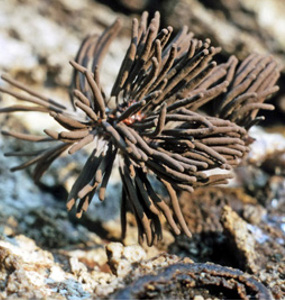Stemonitis fusca

Image Courtesy of Peter Katsaros
| Click to Enlarge |
| Click For Image Gallery |
|
Group of Fungi: Slime Molds Family: Stemonitidaceae Latin Name: Stemonitis fusca Roth Common Name: None Description: Slender, cylindrical structure, 1/4–3/4 in (0.5–2.0 cm) tall and up to 1/32 in (0.1 cm) wide, tufted, occurring in small or sometimes rather extensive clusters, deep fuscous to dark reddish brown; stalk black, shining, 1/8–3/8 (0.3–1.0 cm) long; spore-bearing surface lacking; spores fuscous in mass. Biological Role: The vegetative stage (called a plasmodium) in the life cycle of this organism feeds upon the bacteria associated with decaying plant material. Habitat: On decaying wood or bark in broadleaf or conifer forests. Geographical Distribution: Found throughout the world. Comments: The slime molds are not true fungi but are found in many of the same situations. Stemonitis fusca is one of the more common and distinctive species likely to be encountered in the forests of eastern North America. The tufts of fruiting bodies are somewhat hair-like in general appearance. This species and Stemonitis axifera are rather similar but can be distinguished on the basis of their overall color, with the fruiting bodies of the latter a bright rust-brown. |
| Go Back |